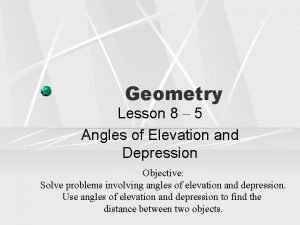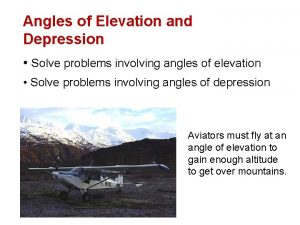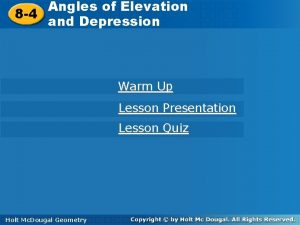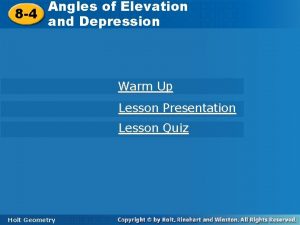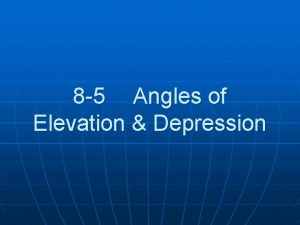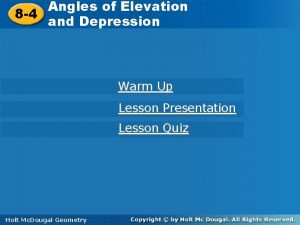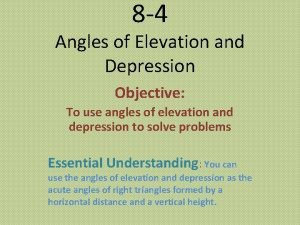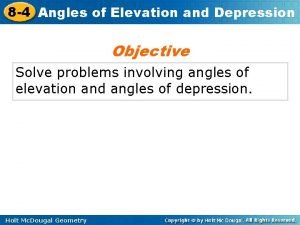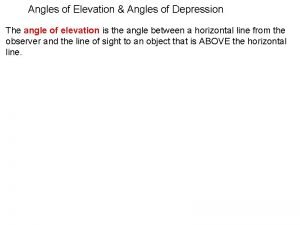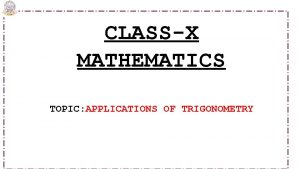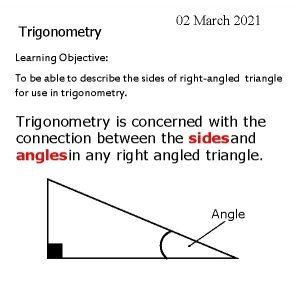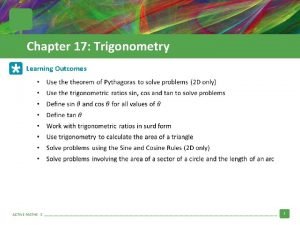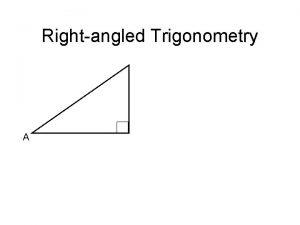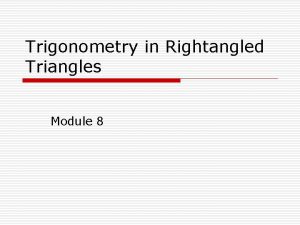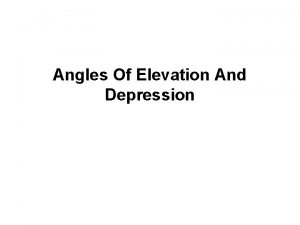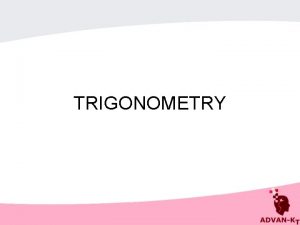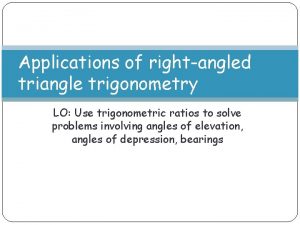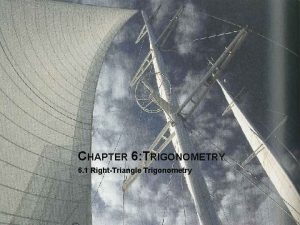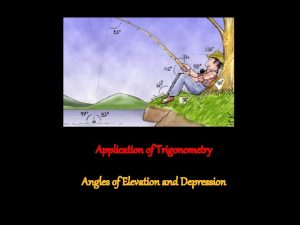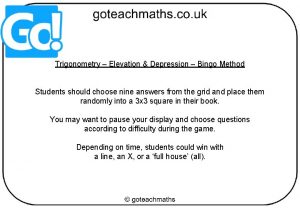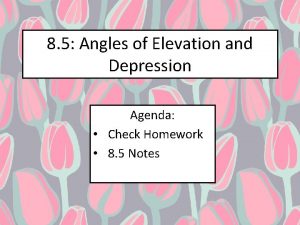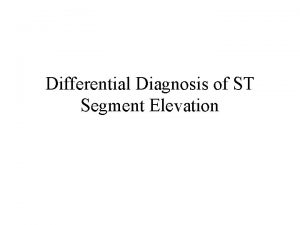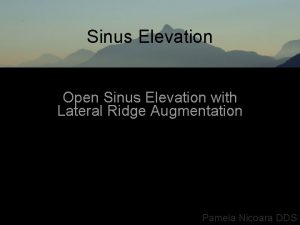ELEVATION AND DEPRESSION Agenda Introduction to trigonometry Rightangled




















- Slides: 20

ELEVATION AND DEPRESSION

Agenda Introduction to trigonometry- Right-angled triangles, theta, etc. Trigonometric functions Angle of elevation Angle of depression Applicability in real life Simple problems involving angles of elevation/depression

Introduction to Trigonometry � Formed from Greek words 'trigonon' (triangle) and 'metron' (measure). � Trigonometric triangles are always rightangled triangles

More on Trigonometry A branch of mathematics that studies • Triangles • Relationship between sides and angles between sides Uses • Describes relationship trigonometric between sides/angles functions

Sides of a Right-angled Triangle Hypotenuse • Opposite to the right-angle • Longest side Adjacent • Side that touches θ Opposite • Side opposite to θ

Theta � 8 th letter of the Greek alphabet � Represented by “θ” � A variable, not a constant � Commonly used in trigonometry to represent angle values

Trigonometric Functions � Sin (Sine)= ratio of opposite side to the hypotenuse � Cos (Cosine)= ratio of adjacent side to the hypotenuse � Tan (Tangent)= ratio of opposite side to the adjacent side

Easier way to remember Sin, Tan, Cos � SOH CAH TOA � TOA: Tangent = Opposite ÷ Adjacent (T=O/A) � CAH: Cosine = Adjacent ÷ Hypotenuse (C=A/H) � SOH: Sine = Opposite ÷ Hypotenuse (S=O/H)

Angle of Elevation � The angle of elevation is the angle between the horizontal line and the observer’s line of sight, where the object is above the observer

Angle of Depression � The angle of depression is the angle between the horizontal line and the observer’s line of sight, where the object is below the observer

Applicability of Angles of Elevation and Depression � Used by architects to design buildings by setting dimensions � Used by astronomers for locating apparent positions of celestial objects � Used in computer graphics by designing 3 D effects properly � Used in nautical navigations by sailors (sextants) � Many other uses in our daily lives

To find sides �

Finding Angles �

Example 1 • Question: You see a huge tree that is 50 feet in height and it casts a shadow of length 60 feet. You are standing at the tip of the shadow. What is the degree of elevation from the end of the shadow to the top of the tree?

Example 2 � From a point 115 feet from the base of a redwood tree, the angle of elevation to the top of the tree is 64. 3 degrees. Find the height of the tree to the nearest foot.

Example 3 � From a point 10 feet from the base of a flag pole, the angle of elevation to the top of the flag pole is 67. 4 degrees. Find the height of the flag pole to the nearest foot.

Example 4 � If the distance from a helicopter to a tower is 300 feet and the angle of depression is 40. 2 degrees , find the distance on the ground from a point directly below the helicopter to the tower

Example 5 � The angle of depression of one side of a lake, measured from a balloon 2500 feet above the lake is 43 degrees. The angle of depression to the opposite side of the lake is 27 degrees. Find the width of the lake

Overall summary • • Draw the diagram Identify the known values Form equations Solve

We hope you have enjoyed our presentation Thank you for your kind attention! Please ask reasonable questions, if any.
 The cross bar of a goalpost is 10 feet high
The cross bar of a goalpost is 10 feet high Elevation and depression questions
Elevation and depression questions Angle of elevation and depression examples
Angle of elevation and depression examples 8-4 angles of elevation and depression
8-4 angles of elevation and depression Two boats are observed by a parasailer
Two boats are observed by a parasailer Lesson 8-4 angles of elevation and depression answer key
Lesson 8-4 angles of elevation and depression answer key Lesson 8-4 angles of elevation and depression
Lesson 8-4 angles of elevation and depression 8-4 angles of elevation and depression
8-4 angles of elevation and depression Angles of elevation and depression
Angles of elevation and depression John wants to measure the height of a tree
John wants to measure the height of a tree Agenda sistemica y agenda institucional
Agenda sistemica y agenda institucional Application of trigonometry mind map
Application of trigonometry mind map Application of trigonometry in real life pdf
Application of trigonometry in real life pdf Label right triangle
Label right triangle Introduction to trigonometry worksheet
Introduction to trigonometry worksheet Trigonometry learning objectives
Trigonometry learning objectives Learning outcome
Learning outcome Introduction meeting agenda
Introduction meeting agenda Introduction meeting agenda
Introduction meeting agenda Mentoring meeting agenda
Mentoring meeting agenda Compare and contrast hoover and roosevelt great depression
Compare and contrast hoover and roosevelt great depression
